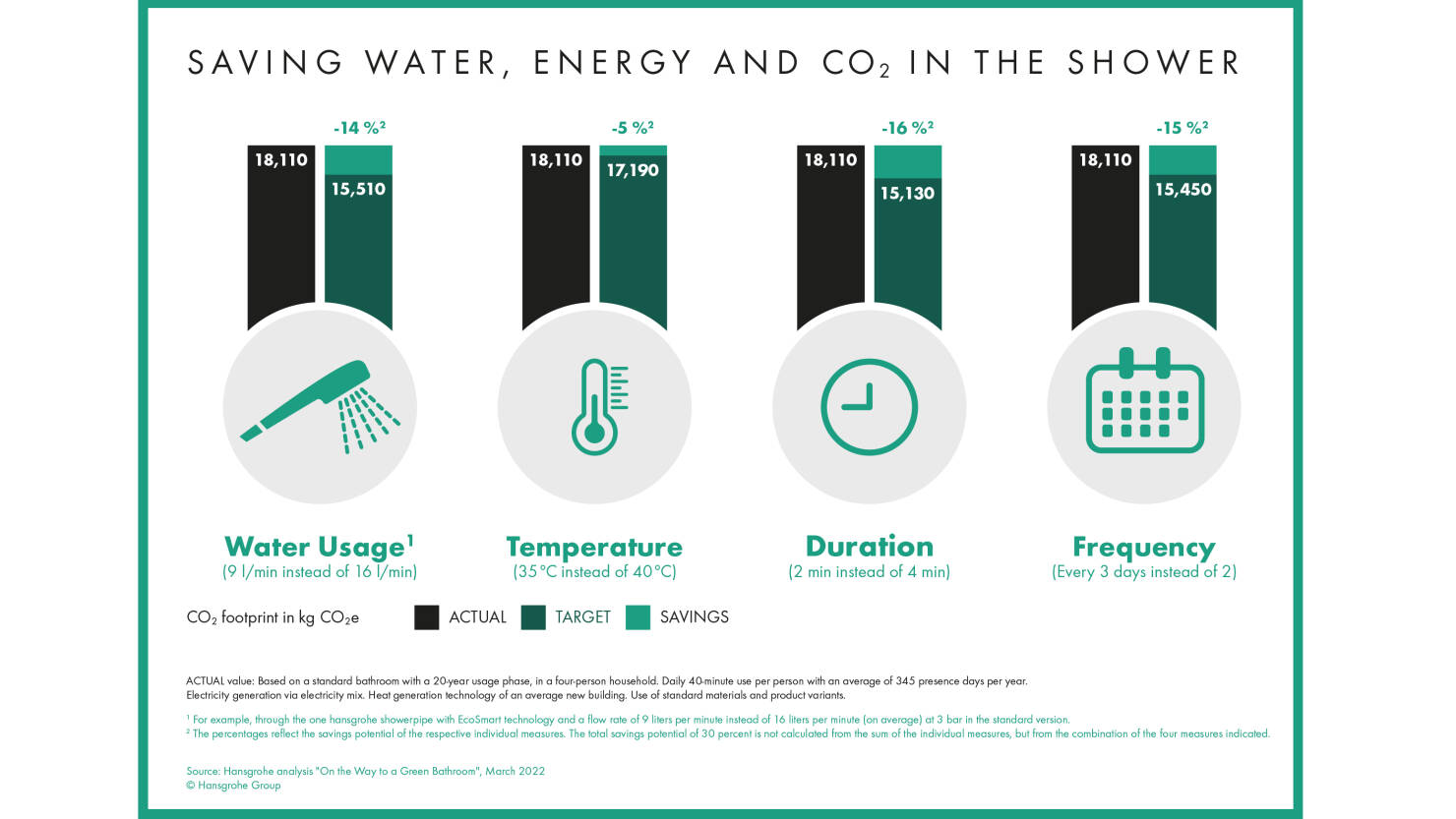Cooler, Shorter and More Energy-Saving Showering: CO2 Savings in the Bathroom
Schiltach, June 2022. The Hansgrohe Group is showing the CO2 footprint of a bathroom at the Greentech Festival 2022 (June 22-24) in Berlin. In an augmented reality installation, Hansgrohe sheds light on the CO2 emissions generated during the construction and disposal phases, as well as in a 20-year usage phase of a bathroom*. The key finding of the underlying analysis: 90 percent of CO2 emissions are attributable to the usage phase of a bathroom. This result is incorporated into the future orientation of the product portfolio of the two brands AXOR and hansgrohe in the faucets and showers segments. "By 2030, we want to convert our entire water-using product portfolio to water and energy-saving technologies. In the future, they must be part of every energy-efficient renovation and new construction. We engage wherever we can jointly adjust emissions-relevant screws in the bathroom and kitchen sector," says Hans Juergen Kalmbach, Chairman of the Executive Board, Hansgrohe SE.
Hansgrohe sees itself as a manufacturer with direct responsibility. "Back in 1987, we introduced our first water-saving product with the Mistral Eco hand-held shower. But private households also bear responsibility by realizing and consciously dealing with their role as hot water consumers and CO2 emitters," says Steffen Erath, Head of Innovation & Sustainability, Hansgrohe SE.
Even a Few Measures Advance Climate Protection
The interactive figures show the savings that are possible: Just using a water-saving shower system consisting of an overhead and a hand-held shower** can save around 14 percent CO2 over the entire usage phase. Innovative technologies such as these not only reduce the flow of water while maintaining showering comfort, but they also cut hot-water-related energy consumption. The current consumer campaign "80 million together for energy change" of the German Federal Ministry of Economics and Climate Protection also points to the energy-saving potential of water-saving showers.
At the same time, a four-person household can reduce its personal CO2 footprint by a total of 30 percent from 18,110 kilograms to 12,680 kilograms over the 20-year usage phase, including production and disposal, by adjusting its showering habits. This corresponds to a saving of 22,630 kWh of energy in hot water production. Such a reduction can be achieved by, in addition to using a water-saving shower system, lowering the shower temperature from 40 degrees Celsius to 35 degrees (five percent), reducing the shower duration from four to two minutes (16 percent) and showering only every third day instead of every second (15 percent)***. If similar measures are also taken for the bathtub and washbasin****, the CO2 footprint can be reduced by as much as 44 percent, from 18,110 kilograms of CO2 to 10,180 kilograms of CO2. In total, 33,890 kWh of energy can be saved in hot water production.
Basis: Analysis "On the Way to a Green Bathroom
” The installation of the CO2 footprint of a bathroom at the Greentech Festival is the result of a scientific analysis by Timo Armbruster (M. Sc.), which he provided for Hansgrohe at the Faculty of Business and Law at Pforzheim University. The calculations relate to a four-person household and consider not only water consumption, but also the bathroom interior and consumables such as toilet paper, toothpaste, liquid soap, deodorant or trash bags. Even the weekly bathroom cleaning and the semi-annual change of the toilet brush are included in the figures. The model bathroom has a size of ten square meters and is state of the art. The emissions calculation assumes modern heat generation technology in new buildings and an electricity mix of fossil and renewable energy sources. Bathroom use amounts to 345 days of attendance per year, with a daily bathroom time of 40 minutes per person per day.
These Levers Positively Influence CO2 Emissions
Three central levers for positively influencing CO2 emissions in the bathroom are relevant. Users who shower less frequently, for shorter periods and with lesser heat, and who use water-saving shower heads, help protect the environment. For their part, manufacturers can use technical innovations to reduce the flow of water in shower heads and offer energy-saving faucet models - such as Hansgrohe's CoolStart technology, among others: Here, the water flow starts with cold water instead of preheated water. A third option: heating water with alternative CO2-neutral energy (solar thermal).
"Everything we do has an impact on the climate. We must be aware of that, each of us. Ideally, however, acting responsibly does not mean foregoing shower comfort, for example," says Steffen Erath. "We're driving our shower and faucet systems forward technologically so that less water per minute doesn't mean less water experience for the user."
We are happy to provide an interactive PDF (for Windows users) to visualize the findings on the " CO2 Footprint of the Bathroom." The infographics are free for publication provided the image rights are acknowledged. For interview requests and background information on the Hansgrohe analysis "On the Way to the Green Bathroom", please contact public.relations@hansgrohe.com.
About the Greentech Festival
The Greentech Festival brings together people, doers, designers and innovation drivers for sustainable living and business. It has established itself as a global platform for the exchange of green ideas and technologies.
About the Hansgrohe Group – Setting the Beat of Water. Since 1901.
With its brands AXOR and hansgrohe, the Hansgrohe Group, based in Schiltach/Southern Germany, enjoys a reputation as a leader in innovation, design and quality within the bath and kitchen industry. Founded in 1901 in the Black Forest, the company gives water form and function with its faucets, showerheads and shower systems. The 120-year history of the company is marked by innovations, such as the first hand-held shower with multiple spray types, the first pull-out kitchen faucet, and the first wall bar to hold a hand-held shower.The company holds more than 18,500 active property rights. The Hansgrohe Group stands for long-lasting quality products and for responsibility towards people and the environment. Sustainable production of resource-conserving products is central to the company’s business activities around the globe. With 34 subsidiaries and 20 sales offices supplying products in 152 countries, the globally active company in the sanitary industry is a reliable partner to its customers in all regions of the world. The Hansgrohe Group, its brands and products have won numerous awards, including more than 700 design prizes since 1974. The products of the Hansgrohe Group are found worldwide: on renowned cruise ships, in luxurious 5-star and boutique hotels, in international metropolitan cities, in extraordinary spas, exclusive bathrooms of lodges and luxury villas, public facilities, as well as in countless private homes. The Group’s high quality standards are ensured by seven wholly-owned production facilities: four in Germany, one each in France, the United States and China. In 2021, the Hansgrohe Group generated a turnover of EUR 1.365 billion. It employs around 5,400 people worldwide, about 60 percent of whom work in Germany.
* Greenhouse gases are defined as six different gases that have a negative impact on climate change. The best known is carbon dioxide (CO2). The effect of these gases is measured and compared in CO2 equivalents (CO2e). If the term CO2 footprint is used, it includes all greenhouse gas emissions.
** For example, through a hansgrohe showerpipe with EcoSmart technology and a flow rate of 9 liters per minute instead of 16 liters per minute (on average) at 3 bars in the standard version.
*** The percentages in parentheses indicate the savings potential of the individual measures. The total savings potential of 30 percent is not calculated from the sum of the individual measures, but from the combination of the four measures indicated. Source: Hansgrohe analysis "On the Way to a Green Bathroom".
**** Bathtub: frequency - every 28 instead of every 14 days, temperature - from 40 degrees Celsius to 35 degrees Celsius, filling volume - from 170 l to 140 l. Washbasin: hansgrohe faucet with CoolStart function, usage time from 195 s to 150 s, alternatively hansgrohe low-flow faucet with a flow rate of 3.5 l/min instead of CoolStart faucet: CO2 savings: 45 percent from 18,110 kg to 9,980 kg. Energy saving: 34,610 kWh
Contact


